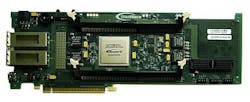Raytheon takes next step toward deploying nation's newest space- and missile-tracking surveillance ship
Cobra Judy is the sea component of the U.S. Department of Defense Cobra program for monitoring missile launches and outer space. The DOD's Cobra program involves the Cobra Judy surveillance ship, as well as the Air Force Cobra Dane active electronically scanned array (AESA) radar at Eareckson Air Station, Alaska, for ballistic missile intelligence gathering; the Air Force Cobra Ball signals intelligence system aboard the RC-135S aircraft for observing ballistic missile flights at long range; and the Cobra Eye system aboard an RC-135X surveillance aircraft for tracking ballistic missile reentry vehicles.
| Related stories -- DOD electronics spending may approach $60 billion in 2006 -- Ballistic missile defense looks to the future -- Multi-sensor fusion hits the mainstream. |
"The Cobra Judy Replacement program marks the first shipboard integration of a true dual-band active phased-array radar suite," says Kevin Peppe, vice president of seapower capability systems at Raytheon Integrated Defense.
The CJR program is to provide long-loiter ballistic missile data collection capability. Its dual-band radar suite consists of X- and S-band phased-array sensors, a common radar suite controller, and related equipment. Now that all of CJR's mission equipment has been installed onto the ship, Raytheon starting shipboard dual-band radar integration and testing.
Raytheon is the prime contractor for the CJR mission equipment and principal on an industry team that includes Northrop Grumman Electronic Systems, General Dynamics SATCOM Technologies, VT Halter Marine, and KOS.
Work on the CJR program is primarily performed at the Raytheon IDS Surveillance and Sensors Center, Sudbury, Mass.; Northrop Grumman Electronic Systems, Baltimore, Md.; and Kiewit Offshore Services. The T-AGM 25 ship was built for the Navy by VT Halter Marine, Pascagoula, Miss.
For more information contact Raytheon Integrated Defense Systems online at www.raytheon.com/businesses/rids.
